Boilers for heating a private house using wood and electricity. Combined and separate boilers for heating with wood and electricity.
Many owners of private houses and summer cottages are faced with the problem of organizing heating due to the lack of a gas pipeline. This leads to the need to search for other energy sources: wood boilers are used, heating the house even in the most spartan conditions.
Wood boilers heating systems have not lost their relevance: they have become much more advanced than their ancient counterparts, while general principles the work remains the same.
Design
A wood-burning boiler belongs to the group of solid fuel devices: not only wood, but also peat, coal and others can be used as an energy source similar materials. The design is a device of several chambers connected to each other by special nozzles. Fuel is immersed in one chamber, the other serves as a place for its conversion into thermal energy.

Roughly speaking, firewood is sent to the device, which burns in another tank, which includes an ash pan. Here not only solid fuels are burned, but also their residues (ash) are stored. The ash pan must be periodically cleaned of waste substances: without this, the equipment will fail. The more advanced the wood-burning boiler, the less ash remains after its operation. A heat exchanger coil branches off from the boiler, which connects to the system and hot water supply if desired.
Scope of application
Wood boilers - universal devices, which can be used in the most various industries, which makes their production profitable and their market position in demand. Solid fuel boilers that burn wood are still used in industry, but the production sector places more severe demands on them than the owners of private houses.
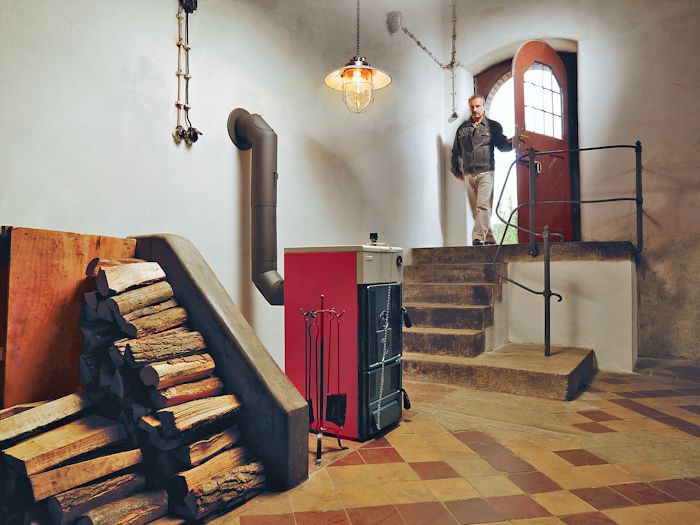
The most common area of application is the construction of private houses and cottages. It is noteworthy that wood boilers operating using hard species fuels, can be used as heat sources in other buildings: for a bathhouse, outbuildings for a farm, etc.
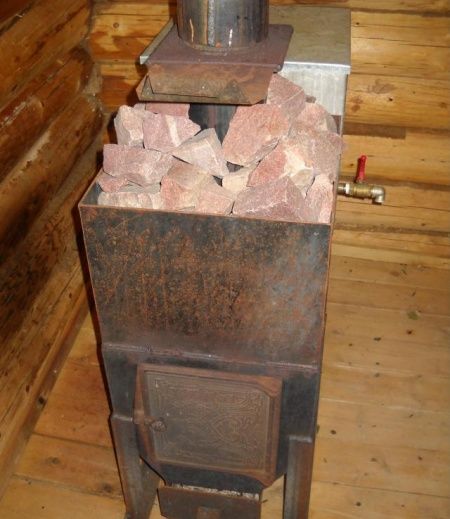
Advantages
Wood-burning boilers for heating have the following advantages:
- high autonomy;
- environmental friendliness and accessibility;
- purchasing fuel will not cause serious financial costs;
- many devices are automated, and therefore there is no need to constantly monitor fuel loading and system circulation.
Thus, the operation of such equipment is well within the budget and lifestyle of the average citizen.
Flaws
A wood-burning boiler has one serious drawback - the need for space for fuel storage - a woodshed, a coal outbuilding, etc. Besides, in home option You need to periodically add firewood and it needs constant cleaning.
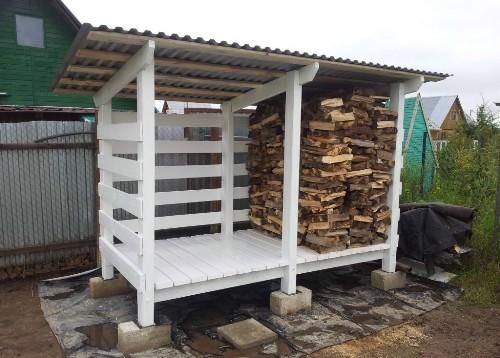
Principle of operation
Mermen heating systems often used solid fuel boilers, working on wood. The design is a diagram of three units: a firebox, a heat exchanger and a pipeline with radiators. The operation is very similar to a wood stove, but with a coil through which the liquid is heated.
Structure
For proper operation wood boilers in a system with a water circuit require the following components:
- boiler room - a complex of a pump, coil, expansion tank;
- chimney for draft and gas removal;
- pipeline, batteries and, if desired, a boiler.
It is worth noting that with natural circulation of the water circuit, wood-burning boilers lose efficiency: condensate flows and soot often clogs. Better to give preference forced circulation with pump and bypass.
Operating principle
The operating principle is as follows: after connecting, the wood-burning boiler receives fuel, which burns and releases heat. This heat energy is received by the heat exchanger and the water in the coil is heated. Due to the difference in density of cold and hot water, the natural circulation– the coolant enters the radiators and, when cooled, returns through processing.
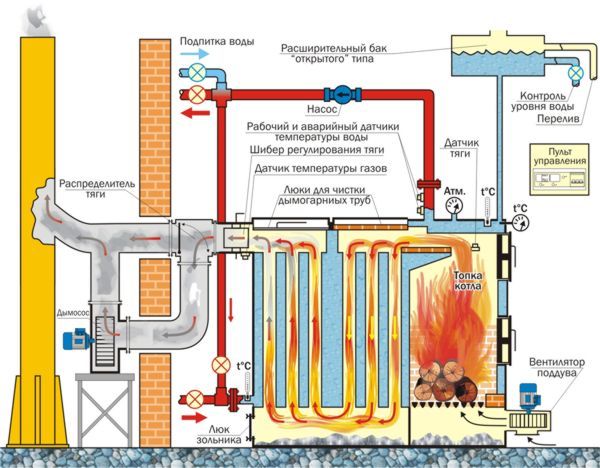
How to improve
Wood-burning boilers make it possible to connect a boiler to provide hot water supply in a private home, as well as a pump to regulate circulation. The latter will make the system dependent on electricity, so together with the pump you need to install a bypass - a switch between forced circulation and natural circulation. The water circuit in the heating system, which includes a wood-burning boiler with a pump, heats the room 2 times more efficiently.
Classification by feed type
Depending on the type of supply, a wood-burning boiler can be manually loaded or with automatic feeding fuel. Manual loading implies long-term burning - such devices can operate on wood for about 70 hours with air supplied through a special telescopic system. This one is simple and reliable design is capable of heating an area of a private house of 20-600 m2, with a power of 7 to 40 kW.
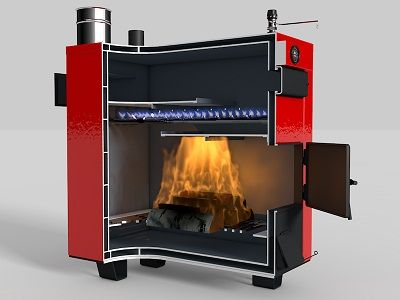
Pyrolysis oven.
Less popular and less expensive type - pyrolysis ovens, operating on wood gas, which is obtained by burning wood on high temperatures. This system is good because it leaves a minimum of ash, but a load of firewood is enough for 10 hours.
Finally, pellet stoves with automatic feeding operate on a special type of fuel - pellets, which are processed and compressed waste from the wood processing industry. If desired, you can use firewood and coal. Such wood-burning boilers are used for huge rooms of 150 m2 and above.
Owners of country cottages when installing heating systems autonomous systems Wood-burning boilers are increasingly preferred. Indeed, it is economical and efficient equipment makes it possible to heat a country house cheaply and efficiently without any additional investments.
How does a wood-burning boiler work for heating a private home?
The combustion chamber is located in the central part of the body. When burning, wood transfers heat to a heat exchanger, which supplies water to the batteries through pipes. It is worth noting that heat comes not only from the heat exchanger, but also from the heated body itself, pipe elements and chimney. When installing modern smoke exhaust systems, special dampers are installed in the pipes, which significantly facilitate the process of cleaning the internal space from ash and soot. Combustion waste also accumulates in the lower tier of the device, which is called the ash pan. Through a cast-iron grate, combustion products are poured into this compartment. It is recommended to clean the ash pan regularly.
Advantages of using wood-burning units
In the PechiMax online store you can buy any heating devices for heating country house and related products at low prices. All presented products have the appropriate certificates and have a number of advantages:
- Autonomy. By installing such a device, you get complete freedom from external factors related to the supply of energy resources;
- Safety for environment. Wood - environmentally friendly pure material, which does not contain all kinds of synthetic additives. Therefore, when it burns, no harmful chemicals are formed;
- Cheap fuel. In almost any region of the Russian Federation you can purchase firewood without problems and at an affordable price;
- Easy to use and maintain.
By contacting our managers, you will receive comprehensive advice on the selection and operation of heating units.
Owners of private houses who use solid fuel stoves for heating are well aware of the problem of cooling down the home after the firewood or coal has completely burned out. This happens at night or during a long departure of the owners, when there is no one to throw new logs into the firebox. The issue can be resolved in several ways:
- use universal boilers for heating with wood and electricity;
- install 2 separate heat sources - solid fuel and electric;
- do not mess with electricity and install a wood boiler long burning.
We suggest taking a closer look at these methods in order to choose the most comfortable option for heating a country house.
Heat sources operating on various energy carriers did not appear yesterday. Since the times of the USSR, “dual-fuel” gas-wood boilers have been known; in them, to switch to wood, the burner device had to be removed. In modern heating units, solid fuel is combined not only with gas, but also with electricity, which is more important for users. A homeowner who decides to buy a heating boiler using wood and electricity solves several issues in one fell swoop:
- It uses two energy carriers for heating, alternative to natural gas.
- Eliminates cooling of the premises of a private house when the contents of the firebox are completely burned and a new portion of coal or firewood is not loaded.
- Increases the convenience of using water heating, since you no longer need to get up in the middle of the night and run to the boiler room.
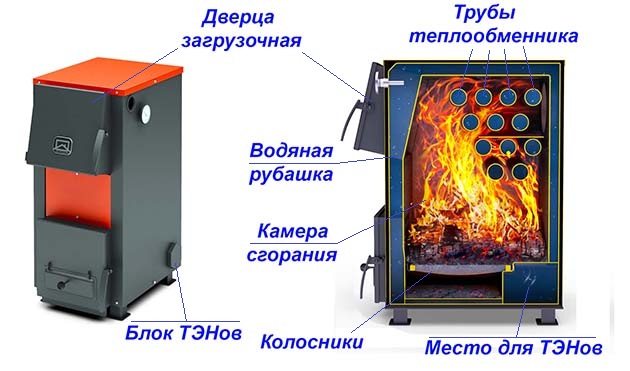
Construction of an electric wood-burning boiler Kupper from the manufacturer Teplodar
The new generation combined heat generators are designed in such a way that electric heating turns on automatically when the water in the boiler tank begins to cool. It is clear that switching back to wood burning without action on the part of the owner of the house is impossible.
The principle of operation of an electric wood-burning boiler
Heater design of this type similar to the device of a traditional solid fuel boiler, consisting of the following main elements:
- combustion chamber (firebox), where logs and coal are loaded;
- from the outside it is washed by a coolant enclosed inside a water jacket;
- heat exchanger of fire-tube or water-tube type, where combustion products give off most heat the water before being released through the chimney;
- the grate is located at the bottom of the firebox, and under it there is an ash chamber;
- the firebox and ash pan at the front are equipped with doors;
- To change the combustion intensity in the heat generator, a mechanical draft regulator or a fan - air blower is used (if manual control of the air damper is not provided).

Schematic diagram of a Kuper-Carbo mine-type electric-coal heat generator
Household combi boilers heating systems differ in the design of the water jacket, which provides space for installing a block of tubular electric heaters - heating elements. Their heating part is immersed in the coolant, and the contacts are brought out and connected by cable to the control panel.
The operating algorithm of a solid fuel heater equipped with electric heaters looks like this:
- The boiler is fired and heated as usual. While the wood is burning, the temperature of the coolant is maintained by a mechanical thermostat or a fan together with a sensor, and the heating elements are inactive.
- After the contents of the firebox burn out, the water in the system begins to cool, which is recorded by the temperature sensor. When the coolant has cooled to a certain point, the sensor signal will turn on the heating element (one or more). From this moment on, the boiler switches to electricity.
- After loading the next portion solid fuel the coolant is heated from the side of the combustion chamber, and electrical part automatically turns off until the next time it cools down.
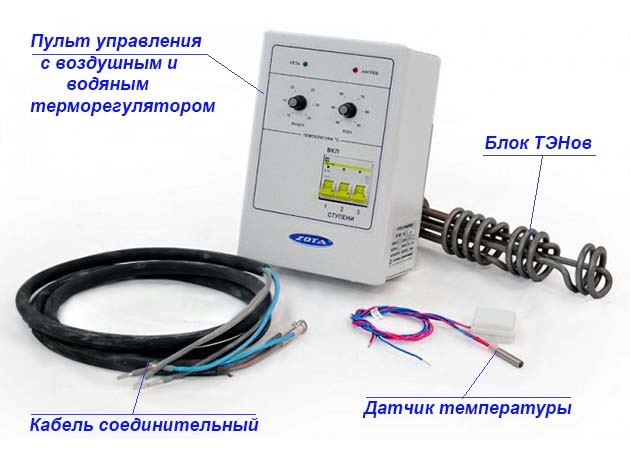
The heater control unit can maintain a certain water temperature based on the readings of the water or air sensor
The transition from one mode to another allows for continuous heating of water, which is what the inhabitants of a private house require for comfort.
Pros and cons of universal boilers
By installing a combination boiler for heating a private house with wood and electricity, you receive the following bonuses:
- Thanks to built-in heating elements water heating will continue to function after the main firebox goes out. This will keep the house warm, and during your absence will prevent pipes and heating radiators defrost.
- Comfort. Supporting the heating of the system with electricity will save you from night trips to the boiler room to lay logs.
- If electricity metering is carried out according to a multi-tariff scheme, then in addition to convenience you will receive savings from the operation of heating elements at night.
Important! Electric heaters universal boilers are designed only to maintain the water temperature in the system; they cannot completely replace the combustion of solid fuel. The reason is the insufficient power of the heating element unit installed by manufacturers on TT boilers. Example: all “Kupper” units of the famous Russian brand “Teplodar” with a power from 9 to 20 kW have electric heaters with equally low heat output - 6 kW.
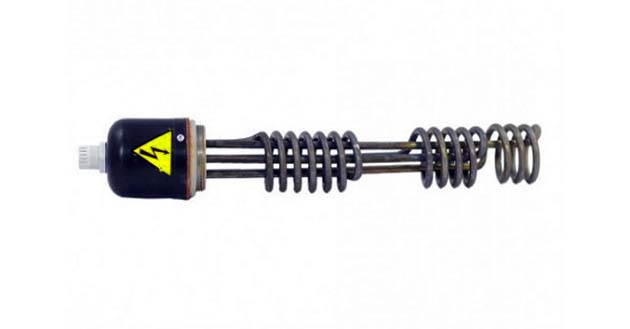
This is what a 6 kW heating element block looks like, used in Russian-made Teplodar, Prometheus and ZOTA wood-burning heaters
This feature of combined heat generators can easily be considered a disadvantage. Exception - heaters low power(the same “Cooper” for 9 kW with 6 kW heating elements), purchased for small-sized dwellings (up to 100 m²). In this case, the heat transfer from electricity is comparable to burning wood, so in moderately cold weather (down to about -5 °C outside), the heaters are able to completely heat a modest-sized house.
Another important point. Like a conventional solid fuel heater, a wood-electric combination boiler should be connected to water heating through a three-way valve, as shown in the diagram below. A small circulation circuit serves to protect the firebox from the harmful effects of condensate during kindling.

To prevent condensation from appearing on the walls of the combustion chamber due to temperature changes, the TT boiler must be connected according to the standard circuit with a three-way valve
If the power of the heating elements is enough to heat the coolant to a temperature of +55 °C and above, then condensation will never form in the combustion chamber of the combined boiler during lighting, and the unit with a three-pass mixing valve seems to become irrelevant. In reality, a small circulation circuit is still needed, at least in case of a power outage or failure of one of the heating elements.
Heating a private house with wood and electricity from one boiler also has other negative aspects:
- The heater block takes away the useful volume of the firebox to the detriment of combustion duration per load.
- The operation of the unit depends on the stability of the power supply.
- The prices of combined products are higher than classic solid fuel boilers.
- The efficiency of electric heaters during operation is reduced by 2-5% due to the air flow passing through the cooled firebox. The reason is the constant draft in the chimney, forcing air from the premises to escape through the fuel duct into the chimney pipe and cool the water jacket of the heater.
To fully replace natural gas electricity and firewood, it is better to take a closer look at another option for heating the building - install 2 separate heat sources, tie them correctly and connect them to the heating system.
Connecting boilers using wood and electricity
Without a doubt, purchasing, installing and wiring two separate units will cost you more than one combined heat generator. But, implementing this option, you get full heating with two energy carriers, operating effectively in automatic mode.
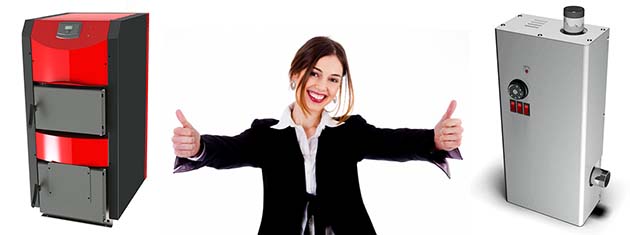
Reference. In non-gas private houses Russian Federation the combined operation of a solid fuel and electric boiler is used quite often, since this is the most convenient way heat your home with wood. The combination of gas and wood is no less common, and the third place is occupied by the so-called multi-fuel boilers, which we will discuss in a separate article.
In our pair of heat sources, the wood (coal) boiler is the main one, and the electric one is the auxiliary unit. As the latter, you can use any of the three types of electric boilers offered on the market:
- traditional heating element with built-in circulation pump and control unit;
- electrode with remote control panel;
- induction with separate remote control.
We will not analyze the advantages and disadvantages of each type of electric boilers; this is the topic of another article. Here we will show in diagrams how to connect boilers using wood and electricity, so that the second one supports the first one automatically. Let's start with the joint piping of a wood-burning and heating element heating unit:

Piping diagram for joint operation of boilers
Reference. The presented circuit can be used for joint connection with gas wall-mounted boiler, which is placed in place of the heating element.
The system operation algorithm looks like this:
- The TT boiler is inactive and its circulation pump is switched off. Heating devices receive heat from an electric boiler, which is guided by a room thermostat, where you have set the desired temperature. To prevent the coolant from moving in a circle through a parallel ring, the circuit uses 2 check valves.
- you melted solid fuel unit. For some time it will begin to gain temperature, and the water will circulate in a small circle, directed by a three-way valve with a thermal head. The pump will turn on at the command of the overhead thermostat installed on the supply pipeline.
- When the coolant in the small ring heats up to 55 °C, the temperature sensor of the thermal head located on the return line will operate. Three-way valve will open slightly and heat will flow into the heating system.
- The electric boiler will turn off the heating upon signal room thermostat and goes into standby mode.
- After the solid fuel burns out, the water in the system, followed by the air in the rooms, will begin to cool. The overhead thermostat of the TT boiler will “see” that the coolant has cooled down and will stop the pump.
- When the temperature in the house drops to the value you set, the room thermostat will turn on the electric boiler again.
Important! Since the internal circulation pump of a wall-mounted heat generator cannot be turned off, a more powerful unit must be selected for a solid fuel heat source. As a rule, a pump with a pressure of 0.6 Bar is sufficient (in an electric boiler it is usually set at 0.5 Bar). Point two: install all overhead sensors and thermostats on metal pipes, on metal-plastic or polypropylene they will lie.
Our expert will tell you in detail about how to properly connect an electric and solid fuel boiler in his video:
Induction and electrode heat generators are not equipped with their own filter and circulation pump, so the latter will have to be purchased and installed separately. This is all the difference in the connection diagram for heaters of this type, only the pump unit needs to be connected to the network through the control cabinet so that the room thermostat turns it off together with the electric boiler, as shown in the diagram:

In this scheme, the circulation pump of the electric boiler will be turned off along with it thanks to a separate control cabinet
If the heating system of a private house consists of several circuits (radiators on different floors, heated floors and a boiler indirect heating), then to work together, the wood-burning and electric boiler are connected using the method of primary and secondary rings. The operating principle of this type of harness is described.
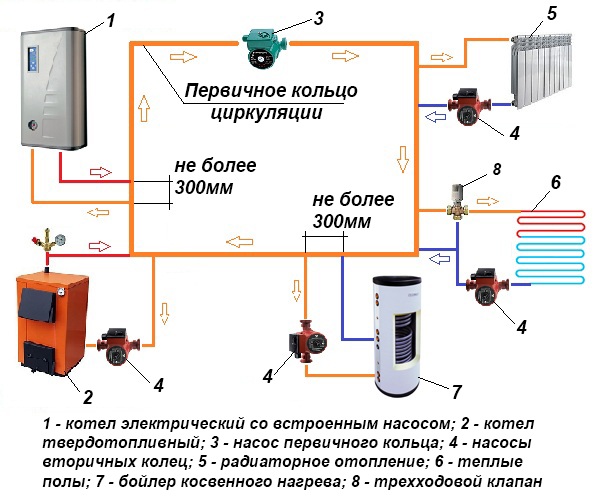
Connecting an electric and solid fuel boiler to the heating system using the primary and secondary ring method
Using long-burning TT boilers
Not every homeowner has the technical ability to connect powerful electrical equipment, which includes combined and pure electric boilers. The reason is the limitation of the allocated power limit, for a private house. The size of the limit depends on bandwidth local power supply networks, which the owner of a country cottage cannot increase.
In the absence of natural gas on the site or when the cost of connecting to the main line is high real way out one is to buy a long-burning wood and coal boiler or make it yourself. The operating time from 1 load for a conventional TT boiler is 3-6 hours, which forces the owner to work near it as a stoker. A comfortable interval between fuel additions is at least 8 hours, and not every heater provides that much.

Cast iron heater with increased firebox volume ATMOS D20
The trouble is that any seedy manufacturer calls their products long-burning boilers in order to sell them to an ignorant user. You can recognize the correct unit among other heat generators by the following features:
- with the same power, a boiler with a large power reserve is equipped with a firebox of increased volume (from 100 l) and differs in size;
- the passport indicates a burning duration of 8 hours (on wood);
- For convenience, the unit is equipped with an additional loading door.
Detailed information about heat generators of this type and recommendations for their selection have been published.
Conclusion
We will offer several conclusions simple tips on organizing comfortable heating of a private home using solid fuel and electricity:
- Combined boiler with wood and electricity - one of best options for a small country house or residential house. In a cottage on 2-4 floors, heating elements can only protect the system from defrosting.
- IN country house over 100 m² it is appropriate to use 2 separate heat sources with proper piping.
- When electricity is supplied intermittently or the power limit does not exceed 5 kW, you should not mess with electricity at all. Find the opportunity to purchase a long-burning heat generator, although the price will be more expensive than usual.
- Don't throw away the opportunity to arrange air heating on wood from the stove, if it has already been purchased or built. As a safety net at night, put electric convectors or fan heaters equipped with thermostats.
The latter method is often used to heat wooden houses in the Scandinavian countries, where homeowners are familiar with bitter frosts first hand. Our latest video is about this:
- Heading:
Many owners of suburban areas do not have the opportunity to use natural gas, so they have to use wood-burning boilers for their summer cottages. Similar modern devices characterized by increased operating time and high coefficient useful action. When purchasing wood boilers for heating your home, you should know about the features of their installation. It is best to hire a professional, as without experience, you can make serious mistakes. In some cases heating device purchased for a greenhouse.
Principle of operation
Heating boilers that operate using wood are very different from traditional ones wood stoves. In their structure they resemble a thermal station. But it is worth noting that the basic principle of operation remains unchanged.
The difference from wood stoves is the presence of a water circuit. The described devices allow you to connect a radiator heating system with a chamber in which firewood is burned. They are divided into two types:
- Pyrolysis. Their difference lies in the fact that they simultaneously use the heat obtained by burning wood and afterburning the resulting gas. It is worth noting that long-burning boilers are very similar in operating principle to pyrolysis boilers. The described devices differ in that one stack of firewood is enough for long work boiler
- Classic boilers. They are devices that work on the same principle as traditional ovens. Such equipment has a low cost, so it is purchased by many owners of private houses.
A solid fuel boiler is a modified wood stove with automation of the combustion process. When purchasing a wood-burning boiler for a garage, you should not choose expensive models that are designed for heating large rooms.

How to choose a device
When purchasing a wood-fired boiler, you need to consider several points:
- The area that will be heated by the boiler.
- Type of heating boiler. As mentioned earlier, there are several types of such devices. Pyrolysis devices are the most economical. But it's worth noting. That they have a higher cost.
- Boiler heat exchanger type. They differ in the type of materials used and in design features. Products made of steel have a lower cost and are not afraid of mechanical damage. It is also worth noting that they are easy to repair and maintain. When purchasing a cast iron boiler in wooden house, it is important to remember that it can be used for 35 years and is afraid of mechanical damage. It is also worth noting that such devices are heavy.
- Camera Features. Many manufacturers produce boilers with the ability to side load firewood. It is also worth paying attention to products with top loading. A similar design is used in gas generator devices. The main advantage is the ability to dry firewood.
- Additional functions. Many boilers are distinguished by the presence of automation. Also, some devices have a built-in boiler and the ability remote control. Greenhouse boilers are usually simpler devices.

In addition, you need to decide on the brand of the device you are purchasing. To do this, it is worth learning more about well-known manufacturers similar equipment for the home. Often, land owners purchase wood-burning boilers for saunas.
Cost of wood boilers
The cost of the products described is influenced by several factors. These include:
- Heat exchanger type. Cast iron products have a higher cost.
- Manufacturer. Some manufacturers' products are more expensive. Often the price reflects the quality of the products.
- The principle of operation of boilers. For example, the cost of a wood-burning gas generator device is approximately 35 thousand rubles. Classic heating boilers have a price of about 20 thousand rubles.
- Availability of additional equipment.
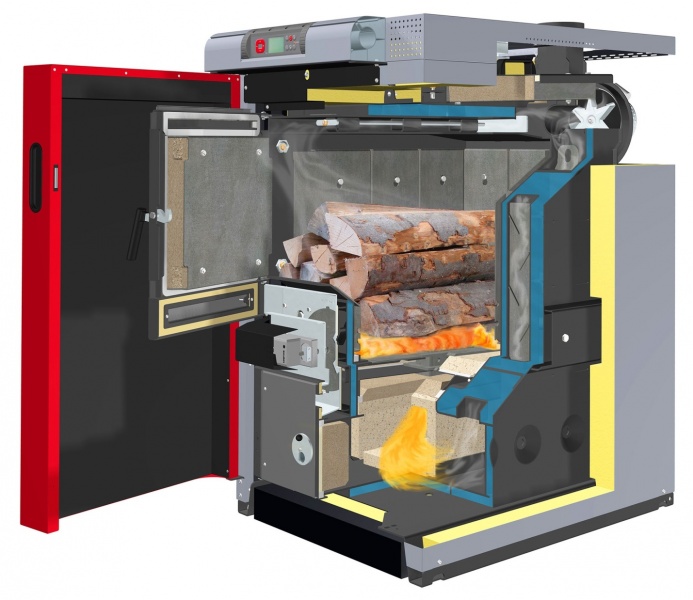
It is worth noting that if the device is registered with Rostechnadzor, documents for commissioning are not completed. Often the product is purchased for a greenhouse. Such devices are quite easy to install.
Boiler installation
Wood burning boilers are connected to the existing radiator system. During such work, it is necessary to observe building codes and rules. It is also important to follow the rules fire safety.
It is important to properly arrange the storage for firewood so that it can be conveniently taken out when necessary. The device usually burns about 15 cubic meters of wood per season. The boiler is installed in the basement or outdoors.

Where should the device be installed?
The described device can be installed anywhere in the house, but it should be remembered that it must comply with fire safety requirements.
Before installation, you should carefully study the following recommendations:
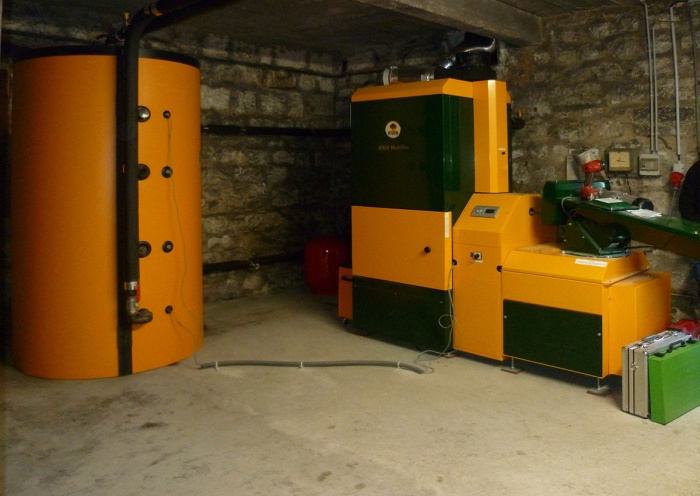
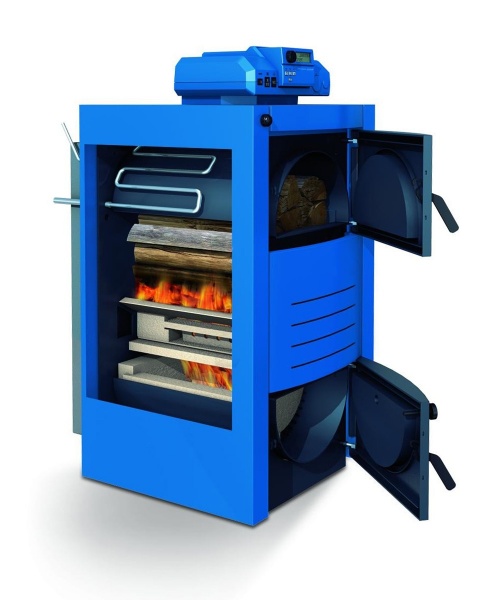
It is worth remembering that connecting a modern boiler requires an electrical network. When using such a device, you should use a voltage stabilizer. Automation is usually connected directly from the switchboard. When installing a chimney, fire safety regulations must be observed.
All heating elements of the described device must be insulated. A spark arrestor must be installed at the pipe head to prevent a fire.
The main requirement when using a boiler is to comply with the basics of fire safety. During operation, it is necessary to ensure that the room does not smoke or the coolant boils. Often the device is purchased for installation in a greenhouse or garage.
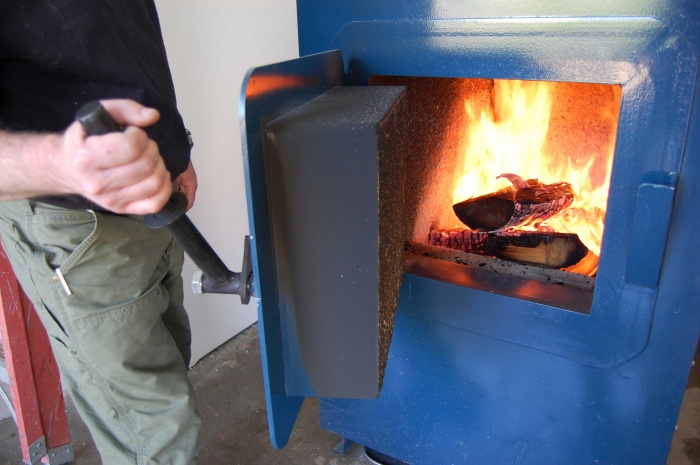
Heating schemes
There may be several heating schemes for a private house in which a wood-burning heating device is installed. They differ from each other in the following parameters:


Before creating the system liquid heating it is necessary to carefully develop the scheme, and during work to comply with building regulations. It is worth noting that when installing circulation pumps it is necessary to connect a voltage stabilizer and a UPS. The described devices are highly efficient and can replace gas equipment.
Nowadays it is no longer so common to find brick kilns who were the most the best way heating in past centuries. Today, the heating industry is rapidly modernizing, because how comfortable and cozy it will be in your private home, cottage or cottage will depend on how correctly and competently the heating system is installed.
In order for your home to have heating and hot water must be conceived at the construction stage. And this heat supply problem can be solved very simply, because big number manufacturers is engaged in the creation of systems and various types heating boilers using solid fuel.
There are five types of boilers, depending on what fuel you plan to use:
- Gas;
- Liquid fuel;
- Solid fuel;
- Electrical;
- Combined.
Let's look at the first three types of boilers in this article.
Solid fuel heating boilers
Solid fuel boilers are heated with wood and coal. There are several types of solid fuel boilers:
- Boilers made of cast iron, fired with coal and wood. Such fuel burns very quickly (about three to four hours) and requires more time.
- Pyrolysis - they are equipped with two combustion chambers. In the first chamber, primary combustion occurs, and in the second, gas combustion occurs. It is better to use hardwood as fuel. Fuel burning time is from six to ten hours.
- Pellet - got its name from the type of fuel - pellets (pelletized and pressed wood). The boiler can independently add required amount fuel in the combustion zone. In such boilers, the burning time depends on the size of the hopper. Everything is automated.
- Long burning boiler. Firewood, sawdust, peat, and a mixture of all three elements are used as fuel. The burning time in such boilers ranges from twelve hours to two days. The combustion process itself occurs from top to bottom, and the fuel does not burn but smolders.
Advantages:
- very unpretentious to fuel;
- the design is quite simple and therefore they will serve you for a long time and will not require much effort for maintenance;
- work without power supply.
Now about the disadvantages:
- Have low productivity;
- Significantly low efficiency (with the exception of pyrolysis boilers);
- It takes a few minutes for the boiler to fully warm up.
- Not suitable for controlling the desired room temperature.
Gas boilers
An excellent solution could be gas boilers for those who have gas installed in their house. Gas boilers come in two types: floor-mounted and wall-mounted.
Floor-standing gas- its heat exchanger is made of durable steel or cast iron. Cast iron walls will be thicker and less susceptible to corrosion. But you should pay attention to the fact that cast iron can burst due to a sudden temperature change. Steel boilers are distinguished by their impact resistance and light weight.
Floor-standing gas boilers can be divided into two types according to their operating principle:
- Atmospheric burners- they are usually installed in boilers of lower power. There are closed type and open. They are easier to use, cheaper and operate quite quietly.
- Inflatable(mixed, ventilated, mounted) burners - have high efficiency, they will cost you more, are usually purchased separately and run on either gas or liquid fuel.
Wall gas- its heat exchanger is made of copper or of stainless steel. Wall-mounted ignition boilers can be:
- Electric- such a boiler will significantly reduce gas consumption. If the power supply is temporarily interrupted, the boiler will turn on itself when the power supply is restored.
- With piezo ignition- when the power supply stops, then you need to manually turn on the boiler.
Advantages of gas boilers:
- They have high efficiency;
- They are generally considered to be very reliable;
- They are easy to use and quite automated;
- Have maximum noiselessness;
- Fuel is quite cheap;
- Very easy to install.
It should also be said about the disadvantages:
- Before you decide to install a gas boiler, you need to register Required documents and obtain permission to install;
- You should be extremely careful because boilers have open flame and gas leakage may occur;
- The room in which installation is planned gas boiler should be easily ventilated and have a chimney and a separate exit to the street;
- The boiler must be equipped with automation to avoid gas leaks in time.
Liquid fuel boilers for heating
In size, they are very similar to gas boilers, differing only in the type of fuel and have their own burners. In everyday life, diesel fuel is most often used as a coolant.
What advantages does it have:
- Can be used without mains gas;
- If necessary, you can replace the burner device with natural gas;
- It has a much smaller chimney diameter compared to atmospheric boilers;
- Very easy to operate;
- Has high efficiency;
- No installation permissions required.
Let's talk about the disadvantages:
- Necessary separate room for installing a boiler;
- Fuel is more expensive;
- The boiler itself is not cheap either;
- Noisier in operation when compared with atmospheric boilers;
- It is always necessary to have a sufficiently large supply of fuel in appropriate containers;
- The boiler quickly gets dirty from burning diesel fuel;
- Domestic diesel fuel contains many by-products, which complicates the process of its purification. Sulfur also increases the chance of corrosion.
